
Hug Point House
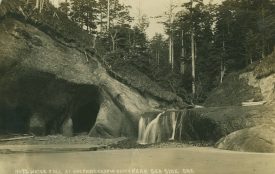
This time of year the beautiful Rhododendrons along the coast are in bloom. Rhododendrons are a hearty, low maintenance plant that does really well at the coast. While driving south on Highway 101 you can’t help, but notice the giant rhododendrons at Hug Point. These beautiful plants once marked the driveway of a beautiful historic home.
The house that once sat atop the fall at Hug Point has become something of a legend. As someone who enjoys finding fact from fiction, I have spent the last several years researching this home. Articles from the 1960s and 1980s indicate that Hug Point caught the eye of a theater magnate in the 1800s. Who this theater magnate was, escaped my research.
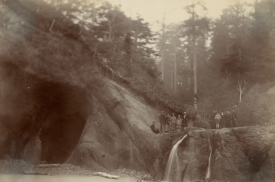
During the late 1800s and early 1900s Hug Point was a popular portrait and sunbathing spot. It was also part of the Oregon Highway. The road wasn’t dynamited until sometime in the 1910s. Prior to this, the road was only accessible at low tide. In the 1930s, a family by the name of Fashers purchased the land and constructed their family home.
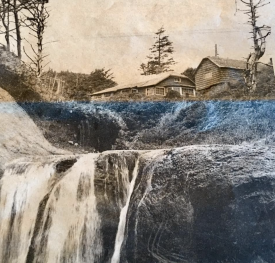
When I spoke with some of the Fashers a few summers ago, they shared fond memories of visiting their grandparents there in the summer and watching their grandfather paint and sketch from a particular window with a rather stunning view of the Pacific Ocean. The home was the kind that caught the eye, not only for the breathtaking location and view, but for its remoteness, and coastal feel; constructed from cedar shake, ship lap, and other locally sourced materials, this home was truly an Oregon Coast home. In an article for “The Oregon Story” long-time resident Donald Osborne writes, “ The Hug Point House has been a unique attraction for locals and passers-by with an eye for the Oregon North Coast’s rugged history. Tucked in between points with the falls below, the house has become an epitome of the way things were in: those days” in Oregon. People — a family — living alone nestled by the ocean, yet protected — a wood fire burning with smoke rising from the chimney. Long winter storms subdued just enough by plans, cedar shakes, and stone. And large, small-paned windows giving just enough view of the rain and wind outside.” The article was dated 1980.
According to the very same article, Oregon State Parks and Recreation Department was leasing the home and property from the heirs of the Fashers. This was also indicated in another article in Coastal Tidings from the 1960s. This article indicates that the land and home were taken over by the parks department in June of 1968. The family, whom I met randomly last summer, indicated that the home and land was donated to the state at that time. They believed that the parks department then leased out the property. This chain-of-events appears to be true, because a letter was sent from the department to “the Cooks” tenants of the home at the time. The letter was dated June 3, 1980, and indicated that the department was terminating their month-to-month lease. The Cooks learned that Hug Point House was to be torn down by the state and they were shocked.
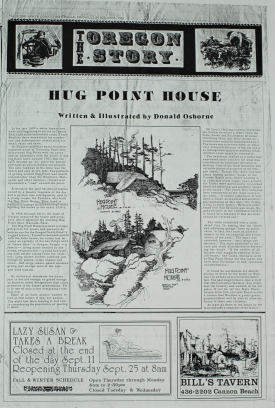
“For years, this home has been considered as the most lovely in the area … it seems ridiculous to tear down a house as beautiful and aesthetically appealing as this one,” the Cooks wrote to the state parks recreation division. The department responded to the Cooks on July 19, 1968, explaining that the home had no public value and that it had, “an adverse impact on the recreational and scenic values of the area.” After some back and forth, it appears that the state allowed the Cooks to live in Hug Point House for another two years before it became vacant. Over the years, many stories have been shared with me about this home. I’ve heard tale of it being a hippie commune at one point. The family of the Fashers that I spoke with didn’t recall that happening and it sounds like they kept tabs on their old family home until it was razed in the late 1970s, or even early 1980s. Other articles from the 1980s indicate that the home was donated by the state to the Cannon Beach Fire Department to be used in a controlled burn training activity. It seems little more than memory and, of course, a few rhododendrons remain of this historic house.
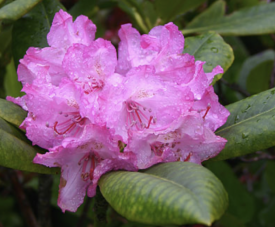
~ As always, with love
Your Resident Nerd
